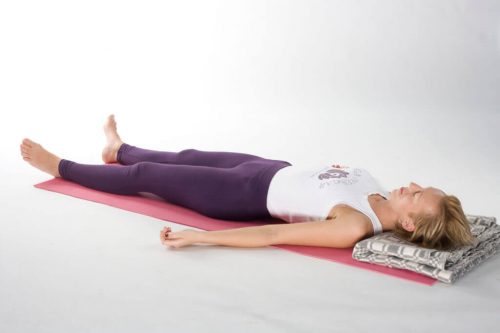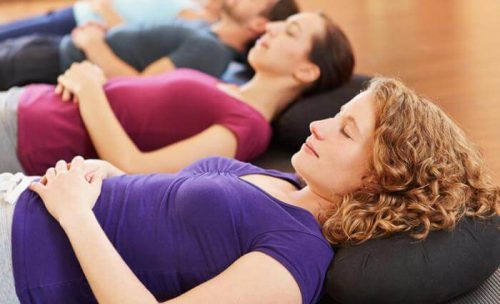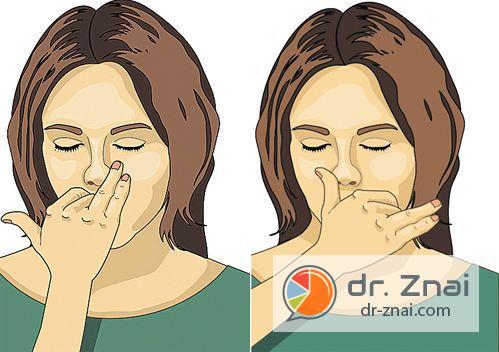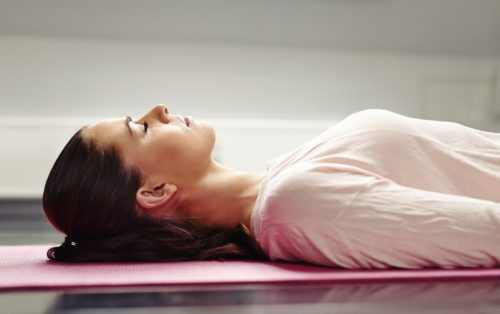Breathing exercises to calm the nervous system, relieve tension and deep sleep
When a person is very worried, they say to him: "breathe deeply." During severe stress, the processes occurring in the body begin to accelerate, so it needs more oxygen. Or, conversely, in situations where a person is in a nervous, tense state that requires increased attention, breathing slows down and becomes rare. For example, while watching a spectacular circus stunt, spectators are in a state that is usually referred to as "watching with bated breath." This interrelation of the psyche and breathing allows the use of regular breathing exercises to calm the nerves. People who master the technique of proper breathing have the ability to control their mood, mental state, and relax the nervous system.
- What kind of breathing is used for relaxation?
- Basic breathing methods
- Rules for performing breathing exercises
- The simplest breathing exercises
- Exercises to Calm the Nervous System
- Breathing to relax and clear the mind
- Breathing exercises for sleep
What kind of breathing is used for relaxation?
Any breathing exercises to calm the nervous system of an adult are based on setting a strict rhythm. After all, it is important to understand that the effect of breathing exercises on the body depends on the strength and frequency of breaths, their depth, and the duration of breath holding. If you breathe shallowly, too often, then small portions of oxygen will enter the lungs, and the calming effect will not be achieved. Moreover, there will be stimulation of the nervous system, which will cause an increase in its activity.

Therefore, any breathing exercises are based on measured and deep breathing. In this case, the lungs are more fully filled with air, which leads to the enrichment of all tissues of the body with oxygen, which normalizes blood pressure, relieves muscle spasm, the brain begins to work better, and the nervous system relaxes.
Basic breathing methods
There are 4 types of breathing in breathing exercises:
- filling with oxygen of the upper parts of the lungs, when breaths are taken by the movements of the collarbones;
- chest breathing, when the ribs open and contract;
- abdominal breathing with the help of the abdominal muscles, due to which the diaphragm begins to move, the internal organs are massaged and saturated with oxygen;
- a wave-like way of breathing, in which the three methods of breathing described above are sequentially activated.
These breathing methods are basic, and on their basis, other breathing techniques have been invented that are used to strengthen and calm the nerves.
Rules for performing breathing exercises

When choosing soothing breathing movements, you need to learn the most important rules for any technique, non-compliance with which will bring all efforts to nothing:
- Any breathing exercises to calm the nervous system should be done in a lying or standing position, in which the back would be completely straight.
- Exercises are best done with closed eyes, meditating and imagining pleasant pictures and images.
- You need to fully concentrate on the process of breathing, at first it will have to be controlled consciously. Gradually, the need for conscious control of inhalations and exhalations, but it will be necessary to continue to concentrate on the very process of breathing.
- The mind should be rid of any negative thoughts, and all muscles should be completely relaxed. The relaxation of the muscles should be done smoothly - from the tips of the toes and further up the body, paying special attention to the face, neck and shoulders, in which the muscles are most tense.
- Calming exercises need to be repeated 5-10 times, but do not overstrain at the same time. Before moving on to the next exercise, you need to wait a bit so that the body has time to adapt.
- While inhaling, you need to imagine how the body, along with oxygen, is filled with calmness and pure energy. During exhalation, you need to imagine how the accumulated tension is “squeezed out” of the body.
- It is also useful during breathing exercises to repeat to yourself settings like “I am calming down”, “I am calm”, “I am relaxing”, etc. Such formulations should not contain negative particles “not” and simply negative content (“I am not anxious ”), and forms of the future tense (“I will calm down soon”).
The simplest breathing exercises

The first breathing exercises are based on nasal breathing, you need to start them with a full exhalation, using complex breathing.
- Belly breathing. The abdomen expands during a deep inhalation and falls down during a slow exhalation. The duration of the breath is 3-4 seconds, after which it is required to hold the breath for a couple of seconds, and then exhale for 4-5 seconds. The interval between breaths is 2-3 seconds.
- Breathing in the chest. Inhale - the ribs "open" for 3-4 seconds, then hold the breath for 2 seconds. After there is an exhalation, the chest “shrinks” for 4-5 seconds. Then 2-3 seconds break, and the exercise is repeated.
- Clavicular breathing, in which the clavicles rise when inhaling, and lower when exhaling. The intervals and duration of the exercise are the same.
- Wave-like breathing, in which the breath begins from the abdomen, then continues through the chest and ends with the collarbones. Exhalation occurs in the opposite direction. The final stage should be carried out especially measuredly.
Exercises to Calm the Nervous System
Often in everyday life you can hear a fairly common phrase: "All diseases are from nerves." Indeed, the state of the nervous system has a close relationship with the state of health. And among those people who do not know how to control their nerves, very often there are hypertension, ulcers, cores.
Exercise #1

This stress relief exercise can be done in any position that suits you - sitting or standing. First you need to take a deep breath. Then you need to hold your breath, mentally imagine a circle and slowly exhale it. Exhale in this way three more circles, and then imagine a square and also mentally exhale it twice.
Exercise #2
The exercise is done lying on your back. It is necessary to establish rhythmic, calm breathing and imagine that with each breath your lungs are filled with vitality, and on exhalation it spills over all parts of the body.
Exercise #3
According to many experts, yawning helps to fill the blood with oxygen and release it from excess carbon dioxide. Also, during a yawn, there is tension in the muscles of the mouth, face, neck, which leads to an acceleration of blood flow in the vessels of the brain. A yawn helps to improve the blood supply to the lungs and expel blood from the liver, increase the tone of the body and create impulses of positive emotions.

These positive properties of a yawn are used by the Japanese, who work in the electrical industry - every half hour they do breathing exercises that help a lot with tension. They unanimously break away from work for a short break in order to yawn in an organized way with the whole team, and then start working again.
A healthy yawn should be correct: it must be done with your eyes closed, and your mouth as wide open as possible. The oral cavity must be tense. In this position, try to pronounce the sound "uuuuu" low and stretched and imagine that a cavity is formed inside the mouth, descending down.
While yawning, you should stretch your whole body. To make the exercise even more effective, you can perform it while smiling. Smiling, as you know, contributes to the formation of a positive emotional impulse and perfectly relaxes the muscles of the face.
Exercise #4
If you have to go through a psychologically tense situation, then in order to maintain self-control in it, self-confidence, conscious control of the situation, it is recommended to do such an exercise. Imagine that in your body at chest level there is a powerful press. Take short and vigorous breaths, clearly feeling the presence of this press in the chest, its strength and heaviness. Then take slow, long exhalations, imagining that the heaviness descends and displaces emotional tension, unpleasant thoughts from the body. Finishing the exercise, you need to mentally “shoot” all the negative emotions into the ground with the press.
Video with exercises to calm the nerves:
Breathing to relax and clear the mind
Exercise #1
Take a fairly deep breath through your mouth, pursing your lips tightly. You need to exhale the air in short jerks, as if pushing it out from the inside, also through pursed lips.
Exercise #2
Take a deep breath, pulling in your stomach. Exhalation is done in short jerks, in portions, through lips folded into a pipe. It is necessary to exhale until the lungs are completely empty. Then wait a few seconds and repeat the exercise.
Exercise #3
Place one hand on your forehead and the other on the back of your head. This position helps to increase blood flow, cleanse the consciousness and mind, get rid of tension and anxiety. Holding your palms in this position, inhale and exhale measuredly, making short breath holdings between inhalations and exhalations.
Exercise #4

Here, the technique of successively clamping the nostrils with the help of the right hand is used. The thumb should be applied to the right nostril, and the little finger to the left. Alternately through both nostrils you need to carry out calm breaths and full exhalations. When the right nostril is blocked, the left hemisphere of the brain is stimulated and vice versa.
Exercise #5
This exercise is used to relieve stress. First, a rather deep, but short breath follows, after which you need to hold your breath for 4 seconds and move on to a deep full exhalation. This is followed by a 5-second pause before the next breath.
Video with calming breathing exercises:
Breathing exercises for sleep
For people who suffer from a disorder such as insomnia, breathing exercises for sleep are recommended, the exercises of which are aimed at training the correct breathing rhythm and normalizing not only sleep, but also the general mental state.
Exercise #1
Take a calm, deep breath, slowly sticking out your stomach, opening your chest and filling it with air. The chest, filled with air, should rise and tighten the stomach. Thus, all parts of your lungs will be filled with air. Then slowly exhale the air from them in the reverse order: first, the lower sections of the lungs are emptied, then the rest, while deflating and lowering the stomach, and then the chest.
Exercise #2

When doing this breathing exercise to improve sleep, you need to make sure that your chest remains as motionless as possible. Take deep breaths, pushing your stomach out, and then exhale the air from your lungs, drawing your stomach back in.
Exercise #3
These breathing exercises for deep sleep will help you relax and cope with insomnia. A very simple technique is used here: 5 minutes to carry out light, slow inhalations and exhalations, concentrating on the breathing process and listening to your own inner sensations. To make this exercise more effective, it is advisable to press your palms to the solar plexus, and breathe with your chest and stomach.
In the early days, breathing exercises before going to bed should be done no more than 2-3 minutes. In the following days, gradually increase the time of classes.
Excessively intense training can lead to excessive alertness and worsening of the process of falling asleep.
When doing gymnastics, you need to carefully monitor your feelings. If you feel tired and tense, you should immediately stop exercising. Do breathing exercises with a good, calm mood, mentally setting yourself up for a healthy sleep.
Do you use breathing exercises to calm your nerves or improve your sleep? Do they help you? Tell us about it in the comments.

